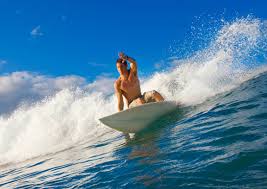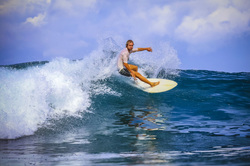With summer upon us, many people around the beaches have been dusting the cobwebs off the old surfboard and making their way back into the surf. It is not uncommon around this time of the year for numerous summer time surfers to make their way into the clinic with sore shoulders, stiff spines and hips.
If you haven’t been out in the surf for several months, it is likely that certain muscles and joints will not be as mobile as surfing requires them to be. The risk of injury will likely be increased further if you work a job that involves sitting down for the majority of the day, likely in a rounded upper back and shoulders position. It is crucial for you to work on any mobility restrictions you have developed over the colder months, so as to minimise your risk of injury when returning to the surf.
To best reduce your risk of injury as well as improve your surfing performance, you would combine dynamic stretches, static stretches, balance, and stability exercises, with a big focus around strengthening you core. Today we will focus on a dynamic stretch/mobility routine that you can perform just before you head out into the surf.
 1. Lateral Squat (Low)
1. Lateral Squat (Low)
Benefits: Loosens your groin to allow you to pop up onto your board in a low squatting position.
How to do it: Stand in an athletic position with a wide base, hips back and down, toes straight ahead. Slide your hips from side to side by bending one knee while straightening your other leg. Keep your chest up and hips low as you go. Do 4-5 reps in each direction.
2. Forward Lunge with Rotation
Benefits: Improves mobility and flexibility of your hips, groin and upper back.
How to do it: Take a large step forward into a lunge, straightening your back leg and placing your hands on the ground for balance. Rotate your torso and raise your left arm up as far as possible behind your right arm. Then reverse the movement, rotating back down and reaching your hand across your body beneath your chest. Do 4-5 reps in each direction.
3. Cobra to Downward facing dog
Benefits: Lengthens to muscles in the front of the trunk and hips to prepare your body for the extended spine position required for paddling and popping up into a standing position. Transitioning into Downward facing dog lengthens the muscles into back of the trunk, the hip and particularly the hamstrings.
How to do it: Lie flat, face down with hands positioned under your shoulder. Point the toes, and engage the thighs and abdomen. Keep the elbows bent and pointing back toward the waist, and curl up into a low backbend. Shoulders move onto the back as the gaze starts to gently move toward the ceiling. This is cobra.
 To transition into downward facing dog, start to tuck the toes under, tuck the tailbone, and tuck the chin. Exhale, lift the hips up and back, take your gaze to the belly button, and straighten out the arms and legs. Do 4-5 reps
To transition into downward facing dog, start to tuck the toes under, tuck the tailbone, and tuck the chin. Exhale, lift the hips up and back, take your gaze to the belly button, and straighten out the arms and legs. Do 4-5 reps
Add these dynamic mobility exercises into your pre-surf routine to reduce your risk of injury, while improving your surfing performance by allowing your body to move freely through the motions your body goes through when surfing.
If you have any pre-existing injuries, or any questions about how to further prepare your body for surfing, then make an appointment with one of our physiotherapists today.
